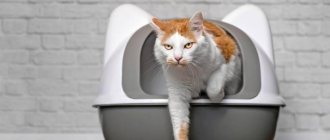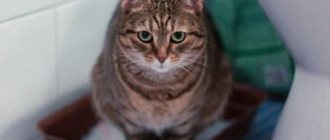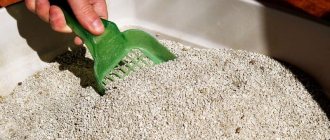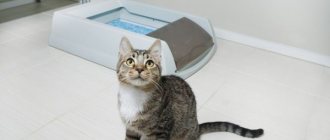Frequent urination symptom (pollakiuria) in cats almost always indicates health problems, some of them are easily corrected and treated, but there are some that lead to the death of the animal. If you notice that the cat pees often, and the norm is to urinate up to three times a day, which means you urgently need to pick up the phone and seek advice from a veterinarian. It is worth knowing what reasons are hidden behind the cat’s frequent trips to the toilet and providing timely help to the animal.
Causes of the disease
Urine excretion is a necessary physiological process through which metabolic products are removed from the body. A pathological condition in which a cat pees more often than usual indicates a malfunction of the urinary system and is called pollakiuria in veterinary medicine.
This term refers to excessively frequent urine output that goes beyond the cat’s daily norm while maintaining a normal volume. Pollakiuria is not an independent disease, but a harbinger of diseases of various organs and systems.
Pathological causes of frequent urination include:
- cystitis;
- urolithiasis disease;
- diabetes;
- urinary tract infections;
- renal and liver failure;
- prostatitis;
- bakvaginitis (in cats);
- malignant and benign tumors, due to which compression of the bladder occurs and its mechanical emptying;
- central diabetes insipidus;
- purulent inflammation of the uterus (pyometra);
- hyperthyroidism;
- Cushing's syndrome;
- kidney pathologies (nephrosis, amyloidosis);
- urinary incontinence;
- Addison's disease.
Often, a cat pees more often than usual due to stressful situations that he has had to endure.
A change of place of residence, the appearance of another pet in the house, noisy companies, and even a regular car trip to the veterinary clinic can negatively affect the animal’s psyche and lead to a reflex contraction of the bladder. When the cat calms down, he will go to the litter box as before.
Another factor in frequent urination is when cats reach a certain age when they begin to become sexually active. Leaving marks is normal and has nothing to do with illness. In this way, the cat shows that he is the master of his territory.
Other signs that trigger urine leakage include old age, extreme thirst, hypothermia, and taking certain medications (anticonvulsants, cortisone, diuretics, etc.).
Is pollakiuria treatable?
Pollakiuria can be a manifestation of various urological ailments, the treatment of which should be carried out systematically and under strict veterinary supervision. Do not even try to treat these diseases at home and at your own discretion - you will cause significant and possibly irreparable harm to your pet.
For cystitis
Cystitis is an inflammatory process of the bladder that usually occurs in adult animals older than twelve months. Fortunately, cats and cats do not get cystitis too often, but you definitely need to know about it. Males are more predisposed to this disease than females, and neutered male cats are at risk.
The disease does not occur on its own - it can be the result of many factors, including the following:
- improper metabolism;
- sand and kidney stones;
- mineral balance disorders;
- improper nutrition (lack of protein, lack of fluid, overfeeding with dry food);
- sexual infections;
- difficult childbirth;
- cold, draft, etc.
The acute form of the disease is painful - the cat meows pitifully, trembles and twitches during frequent urination. The color and smell of urine changes, and blood often appears in it. The animal is in a depressed state, has a domed back and strives to constantly lick the perineum.
With cystitis, the cat becomes nervous and often licks the perineum and hind legs
To cure cystitis, it is necessary first of all to block the source of infection. After establishing an accurate diagnosis, the doctor may prescribe the following medications for the treatment of cystitis:
- antispasmodics - to alleviate the condition of the animal and relieve pain;
- antibiotics - if cystitis is bacterial in nature;
- hemostatic drugs - for hemorrhagic cystitis;
- antiseptics and diuretics.
Video: cystitis in a cat
For urolithiasis
Unfortunately, urolithiasis is quite common in cats, and its consequences are very dangerous for animals. There are also many causes of the disease:
- genetic predisposition - individual or breed;
- disturbances of normal metabolism;
- improper feeding - and obesity as its result;
- low-quality water with an excess of mineral salts;
- infections of the genitourinary system.
One way or another, concretions (stones) are formed due to a lack or, conversely, an excess of certain mineral elements and can be different in composition. It is very important to identify the type of stones as accurately as possible - both the methods and the final success of treatment depend on this. To determine the composition and type of stones, it is necessary to conduct a pH test of urine.
Diagnostic methods will allow you to learn as much as possible about the nature of the disease
There are several types of stones in urolithiasis:
- struvite type;
- oxalate type;
- urate type;
- cystine stones;
- phosphates;
- silicates;
- mixed stones.
A particularly dangerous condition is when the pet cannot pee, the bladder becomes full, and its stomach swells literally before our eyes - in this case, contacting a doctor must be very urgent, otherwise the animal may die.
Treatment of urolithiasis can be either conservative or surgical. Conservative treatment can be limited to if the stones are small or of a composition that can be dissolved with the help of medications. If the stone is too large or conservative methods do not produce results, then the doctor decides to remove the stone surgically.
After surgery, the cat must wear a special bandage to protect the stitches.
Along with the main drug therapy, antibacterial drugs are usually prescribed, since the sharp edges of the stones damage the tissues and pathological microorganisms enter them, which leads to the development of infections. In such situations, long-acting and broad-spectrum antibiotics are indicated:
- Ceftriaxone;
- Cephalexin;
- Cefotaxime;
- Suprax;
- Rocephin, etc.
At the discretion of the doctor, anti-inflammatory drugs and drugs aimed at improving urine flow - diuretics - can also be used.
A positive treatment result is impossible without a diet - a balanced diet of a special composition; The following foods are best suited for this:
- Hill's Prescription Diet Metabolic + Urinary Feline dry;
- Royal Canin Urinary S/O LP34;
- 1st Choice Urinary;
- Bosch Sanabelle Urinary;
- Farmina Vet Life Cat Struvite.
Supporters of natural nutrition will have a much more difficult time - it is better to prepare a diet for a sick cat not on your own, but based on the recommendations of a veterinarian.
Don't let your cat drink water directly from the tap - it contains too many salts
An animal, especially if it eats freeze-dried food, must have constant access to high-quality water - clean and soft. You can soak ready-made food with this water - this way they are better absorbed, and cats eat them more willingly.
Video: diagnosis and treatment of urolithiasis in a cat
For other diseases
You should not self-medicate for other diseases, the symptom of which is frequent urination, especially since a non-specialist will still not be able to accurately diagnose the disease on his own.
Kidney failure
Here, animals older than eight years are at risk. This is a very serious disease - renal failure requires intensive and systemic therapy, otherwise the animal will die.
Diabetes
The disease has a genetic predisposition, however, as in humans, it often develops against the background of poor nutrition and constant stress. At risk are sterilized individuals and obese animals. A strict diet is required, and in the second type of disease, constant insulin support is required.
Cats get diabetes at least as often as people
Enuresis
Urinary incontinence is an independent illness, and not a consequence of other diseases, physical or even psychological trauma. It will take a lot of attention and patience from the owner to get to the root cause of what is happening, and then fix the problem.
Main symptoms
Signs of urinary dysfunction are visible to the naked eye: the cat pees more often than usual. If the volume of daily urine excretion is exceeded, then we are no longer talking about pollakiuria, but about polyuria. This can be understood by the litter in the cat's litter box.
For example, if you used to change it once a week, and recently - 2-3 times a week, it means that a serious failure has occurred in the cat’s body. For reference: the normal volume of urine excreted in an adult cat is on average 28 ml (about half a tea cup) for 2-3 visits to the litter box per day.
Frequent urination may be accompanied by other signs - increased thirst, discharge of blood and pus along with urine, fever, weight loss. Due to frequent urination, the water-salt balance is disturbed and the appearance of the pet worsens.
The fur on the hind legs, belly, and lower part of the tail is constantly wet, emitting an unpleasant odor. For cats, which are naturally very clean animals, this causes considerable discomfort, forcing them to constantly lick themselves.
It is worth observing the cat's condition. Perhaps the dry food is too salty or she has eaten too much of it. If pollakiuria is associated specifically with the diet, then within a day urination will normalize.
Normal amount of urination in cats
Normally, the daily number of urinations depends on the age and sex of the animal:
- Very small kittens up to 3 months old can urinate only once a day;
- from 3 to 5 months, the frequency of urination gradually increases and can reach 6 times a day;
- an adult cat urinates 1–2 times a day, but the frequency of visits to the litter box may increase during estrus and pregnancy;
- an adult cat urinates 3–4 times a day, a neutered cat urinates up to 5–6 times.
The difference in the frequency of urination between male and female cats is explained by differences in the structure of the urinary tract, which is further narrowed in castrated cats. Each animal has an individual norm, which does not differ much from the average, but it is this that serves as a guideline when it comes to changing the frequency of urination.
Diagnostics in a veterinary clinic
To make a correct diagnosis, a veterinarian needs to conduct the necessary diagnostic tests. After a visual examination of the animal and collection of anamnesis, the specialist prescribes for the cat:
- blood and urine tests;
- Ultrasound of the kidneys, bladder, abdominal cavity;
- radiography;
- seeding on nutrient media (in case of possible bacterial infection);
- studies on the hormonal antidiuretic complex.
When conducting diagnostics, the veterinarian excludes factors such as increased salt intake, medications, and infusion therapy.
Diagnosing the problem
You can try to determine the cause of frequent urination yourself, but this is not the best solution, because being a non-professional, you can miss really important details and symptoms.
The problem will not necessarily be superficial - it is quite possible that extremely dangerous inflammatory processes are occurring in the animal’s body, or some other disturbances in the functioning of internal organs.
Even if the reasons seem obvious, it would still be a good idea to consult a veterinarian. If the treatment turns out to be incorrect, the disease will only progress, and in the end it can even lead to the death of the animal . With the help of a number of special studies, the veterinarian will be able to reliably determine the cause of the disease and select individual treatment. In a veterinary clinic, several types of tests, ultrasound examination of internal organs, and x-rays are used for diagnosis.
© shutterstock
If the cat often runs to the toilet little by little (even to the point that it returns to the litter box every few minutes), it is quite possible that this is due to acute cystitis. In this case, correct treatment will get rid of the disease in just a few days. Lack of treatment can lead to the disease becoming a chronic condition that will last for many months.
Noticing the problem in time and contacting a specialist is the main task for the owner.
Treatment method and prognosis
There is no single treatment regimen for pollakiuria. Therapeutic procedures are prescribed after diagnosis. As mentioned above, pollakiuria can be a sign of a dangerous disease, so treatment will be aimed at eliminating it.
Thus, for diabetes mellitus, insulin therapy is an important stage of treatment. With the help of drip infusion of polyionic drugs, the water-salt balance is restored. The key to successful treatment and recovery or maintaining quality of life at a satisfactory level is nutritional correction and quality care.
It often happens that the pet will be limited in physical activity for the rest of its life, take appropriate medications and eat exclusively special medicinal food.
If pollakiuria is caused by stress, then, first of all, it is necessary to eliminate the source of psycho-emotional stress. To reduce the negative effects of stress, your veterinarian may prescribe anti-anxiety medications, such as Stop-Stress.
Cat marks are an unpleasant phenomenon, but an animal cannot be punished for it. The best way out would be castration or the sedative phytohormonal remedy Kot Bayun.
Antispasmodics are indicated to relieve pain; antibiotics and sulfa drugs are used to eliminate infections.
The prognosis for pollakiuria again depends on the underlying disease. If, for example, we are talking about an infection, then one course of antibiotic therapy is enough. But for malignant and benign diseases, veterinarians are no longer so optimistic in their forecasts.
Stressful situation
This disorder can create serious problems not only for humans, but also for cats. Due to stress, immunity decreases, which can subsequently provoke infections and inflammatory processes.
A cat may find itself in a stressful situation due to sharply changed odors, a change in tray or sleeping place, a change in diet, moving, or the appearance of other pets.
The following symptom may indicate stress: the cat goes to the toilet little by little and often, and there is blood in the discharge. At the same time, there may be very little urine. A stressful situation can also be determined by the behavior of a cat - the animal will be very anxious, overly aggressive or, conversely, too apathetic. A cat can also communicate its stress by meowing loudly and frequently, periodically turning into a scream.
If stress causes your cat to pee frequently, a blockage in the urinary tract could even be one of the reasons. If this is the problem, you need to contact a veterinarian as quickly as possible - this condition poses a threat to the animal’s life.
© shutterstock
What to do at home
The pet owner must follow the veterinarian's instructions. Self-medication is dangerous to health! Uncontrolled use of drugs or replacement of conservative treatment with folk remedies can cause irreparable harm to the cat’s health.
A sick furry cat should be provided with good care and adequate nutrition. It would also be useful to take vitamins, which are also prescribed by a specialist.
Causes not directly related to the disease
Infectious diseases and inflammation of internal organs are not always the reason why a cat often visits the litter box. This is especially true for kittens and young animals under the age of one year, since cystitis occurs extremely rarely in them. So, there are several possible reasons for frequent visits to the toilet that are not related to infection or inflammation:
- Stressful situation.
- Intense thirst.
- Marking the territory.
Below, all of these problems are discussed in more detail.
Treatment
For cystitis due to stress
sedatives are prescribed, such as “express calm” for cats or special diets (royal canin calm). But it is important to understand that treatment will be ineffective if the cause of stress is not eliminated.
Bacterial cystitis
treated with antibiotic therapy. But it should be noted that to make a diagnosis and select a drug, it is necessary to conduct a special study. This is taking a sterile urine sample through a puncture of the abdominal wall and submitting it for bacteriological culture with antibiotic titration (that is, selecting a drug that best copes with the found bacterium). Only in this case is it possible to defeat the infection, prevent its reoccurrence and the development of antibiotic-resistant strains of microorganisms.
Treatment of urolithiasis
completely depends on the nature of the stones that are found in the cat, so analysis is indispensable. For example, if struvite salts (synonym - tripel phosphates) are detected in a urine test, it is sufficient to prescribe a special diet (for example, royal canin urinary) and improve the cat's drinking regime (switching to wet food, purchasing special fountains for cats, from which they drink water more readily, than from a bowl). Other types of salts (for example, oxalates) require an individual approach and a treatment regimen depending on the concomitant diagnoses in the cat (for example, these salts are often found in cats with kidney disease).
Mechanical damage to the bladder
after catheterization requires the development of treatment tactics in each specific case. Pain medication, antibiotics, and even possible surgery may be needed.
If you suspect a tumor in the bladder
First, a histological analysis is taken to determine the type of tumor. Depending on the results, treatment is prescribed - chemotherapy, removal of the tumor or the entire bladder.
In most cases of kidney disease
, unfortunately, are incurable and require only supportive treatment. But, in modern conditions, with timely treatment, it is possible to extend the life of a cat with kidney disease by several years!
Diabetes
in cats, as in people, it requires insulin injections, and necessarily a special diet and weight loss. With timely treatment, constant monitoring of blood sugar levels and individual selection of insulin dosage, in about half of cases, diabetes in cats can be completely cured!
Various hormonal diseases
require constant monitoring of blood tests and selection of the dose of hormonal drugs. In some cases, if the disease is caused by a tumor, surgery to remove it is recommended. Only an endocrinologist can deal with such patients.
Associated symptoms
Depending on the cause of frequent urination, it may have various accompanying symptoms:
Against a background of stress
, in addition to the fact that the cat often pees, it can hide in closets, under the bed, and refuse food and water.
For bacterial cystitis
The cat usually doesn't feel well. She is lethargic, eats little, and may even vomit.
For urolithiasis
, especially when it is completely difficult to empty the bladder, cats stop eating and drinking. They constantly run into the tray, sometimes even sleep there, regularly strain on the tray and meow pitifully. As a rule, cats also have severe stomach pain, and they do not allow it to be touched.
With mechanical damage to the bladder
After catheterization, a sharp deterioration in the cat’s condition may be observed. There is urination with blood, cystitis, or, conversely, its complete absence. Also, due to the pain factor, the cat may refuse to eat and generally be sad.
Presence of a tumor in the bladder
, as a rule, has no other symptoms other than frequent urination. The condition is characterized by a gradual deterioration.
For kidney diseases
cats begin to lose weight, their coat becomes dull and dirty. Cats often refuse to eat and vomit occasionally. It is also common for cats with kidney disease to have bad breath. Cats become sad, don’t play, and sleep all day.
For diabetes
, in addition to profuse thirst and constant urination, the pet is characterized by significant obesity and the so-called perverted appetite - cats may begin to eat foods that they have never eaten before. But at the same time, with an excessive increase in blood sugar levels, on the contrary, cats may become lethargic and refuse to eat.
In the presence of hormonal diseases
cats can have a variety of symptoms. Often this is a sharp decrease in weight, poor coat quality, and the belly may be enlarged. At the same time, appetite, as a rule, does not disappear, and may even increase.
Main
- There are many reasons for frequent urination, from cystitis to serious systemic diseases.
- Regardless of age, if a cat pees often and little, this is always a pathology that needs to be understood and treatment selected.
- To make a diagnosis, a comprehensive diagnosis is required. In most cases, this is a urine test, blood tests, and ultrasound of the genitourinary system.
- There is no symptomatic treatment in this situation, since in each specific case it is necessary to look for the cause of the disease and treat it.
Diagnostics
As noted above, if a cat pees often, there can be many reasons for this. Therefore, in order not to miss a serious deterioration in the pet’s health and to begin treatment on time, it is necessary to conduct a full diagnosis.
Diagnostics must include:
- Detailed urine analysis.
It looks at the density of urine (kidney function), the amount of protein (inflammation, kidney function), the presence of sugar (diabetes), acidity, sediment, and so on. Each of these indicators can be decisive in making a diagnosis.
- General blood analysis.
It may show the presence of bleeding due to bladder injury, an increase in the number of white blood cells due to infection, etc.
- Blood biochemistry.
It shows blood sugar levels and allows you to evaluate kidney function (creatinine, urea, phosphorus). Elevated liver enzymes may indicate the presence of endocrine diseases.
- Ultrasound of the genitourinary system
. This is the most important diagnostic method that allows you to assess the condition of the bladder, in particular its walls, the presence of stones, salts, and neoplasms. The condition of the kidneys, ureters, and the visible part of the urethra is also necessarily assessed.
But, of course, there are exceptions when drawing up an examination plan. For example, if the pet is young, he has not had any health complaints and there is a suspicion of stress
, in most cases, you can limit yourself to performing an ultrasound of the abdominal cavity.
If bacterial cystitis
, urine must be collected in a sterile manner using cystocentesis (puncture of the abdominal wall) and sent for analysis: bacteriological culture with selection of an antibiotic.
Make an accurate diagnosis of urolithiasis
is possible only by submitting the removed stone for a special analysis to determine its structure.
If you suspect mechanical damage to the bladder
After catheterization, ultrasound may be sufficient. But, to assess the dynamics of recovery, it is necessary to conduct several examinations.
When visualizing a tumor in the bladder
, in addition to a complete examination of the cat to exclude the presence of other neoplasms (in this case, it is best to perform a computed tomography), to take a piece of the tumor for histology analysis, a puncture (biopsy) is required. Only in this case can the nature of the tumor be determined and special treatment prescribed.
If you suspect kidney disease, diabetes mellitus and other hormonal
The disease requires a thorough and comprehensive diagnosis of the pet. Also, in each specific case, the doctor may prescribe additional tests to clarify the diagnosis (for example, blood tests for indicators such as SDMA, cortisol, etc.)
Hurry up, choose a box and find out what gift awaits you
Discount on pet insurance
Promo code copied to clipboard











